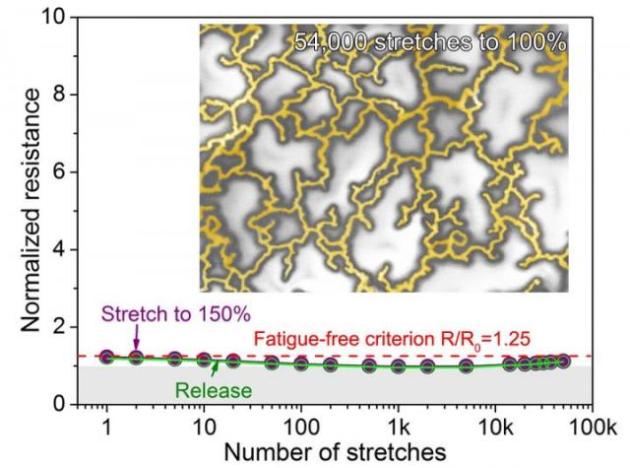Sep 23 2015
Researchers have discovered a new stretchable, transparent conductor that can be folded or stretched and released, resulting in a large curvature or a significant strain, at least 10,000 times without showing signs of fatigue.
 Fatigue-free flexible transparent electrode for stretchable and bendable electronics. Credit: University of Houston
Fatigue-free flexible transparent electrode for stretchable and bendable electronics. Credit: University of Houston
This is a crucial step in creating a new generation of foldable electronics - think a flat-screen television that can be rolled up for easy portability - and implantable medical devices. The work, published Monday in the Proceedings of the National Academy of Sciences, pairs gold nanomesh with a stretchable substrate made with polydimethylsiloxane, or PDMS.
The substrate is stretched before the gold nanomesh is placed on it - a process known as "prestretching" - and the material showed no sign of fatigue when cyclically stretched to a strain of more than 50 percent.
The gold nanomesh also proved conducive to cell growth, indicating it is a good material for implantable medical devices.
Fatigue is a common problem for researchers trying to develop a flexible, transparent conductor, making many materials that have good electrical conductivity, flexibility and transparency - all three are needed for foldable electronics - wear out too quickly to be practical, said Zhifeng Ren, a physicist at the University of Houston and principal investigator at the Texas Center for Superconductivity, who was the lead author for the paper.
The new material, produced by grain boundary lithography, solves that problem, he said.
In addition to Ren, other researchers on the project included Chuan Fei Guo and Ching-Wu "Paul" Chu, both from UH; Zhigang Suo, Qihan Liu and Yecheng Wang, all from Harvard University, and Guohui Wang and Zhengzheng Shi, both from the Houston Methodist Research Institute.
In materials science, "fatigue" is used to describe the structural damage to a material caused by repeated movement or pressure, known as "strain cycling." Bend a material enough times, and it becomes damaged or breaks. That means the materials aren't durable enough for consumer electronics or biomedical devices.
"Metallic materials often exhibit high cycle fatigue, and fatigue has been a deadly disease for metals," the researchers wrote.
"We weaken the constraint of the substrate by making the interface between the Au (gold) nanomesh and PDMS slippery, and expect the Au nanomesh to achieve superstretchability and high fatigue resistance," they wrote in the paper. "Free of fatigue here means that both the structure and the resistance do not change or have little change after many strain cycles."
As a result, they reported, "the Au nanomesh does not exhibit strain fatigue when it is stretched to 50 percent for 10,000 cycles."
Many applications require a less dramatic stretch - and many materials break with far less stretching - so the combination of a sufficiently large range for stretching and the ability to avoid fatigue over thousands of cycles indicates a material that would remain productive over a long period of time, Ren said.
The grain boundary lithography involved a bilayer lift-off metallization process, which included an indium oxide mask layer and a silicon oxide sacrificial layer and offers good control over the dimensions of the mesh structure.
The researchers used mouse embryonic fibroblast cells to determine biocompatibility; that, along with the fact that the stretchability of gold nanomesh on a slippery substrate resembles the bioenvironment of tissue or organ surfaces, suggest the nanomesh "might be implanted in the body as a pacemaker electrode, a connection to nerve endings or the central nervous system, a beating heart, and so on," they wrote.
Ren's lab reported the mechanics of making a new transparent and stretchable electric material, using gold nanomesh, in a paper published in Nature Communications in January 2014.
This work expands on that, producing the material in a different way to allow it to remain fatigue-free through thousands of cycles.